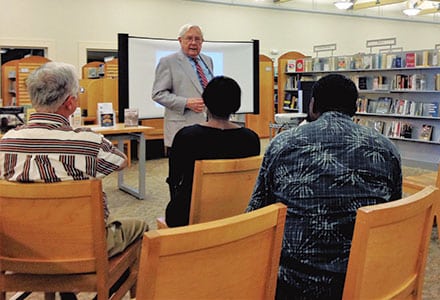
“We are living history and we each have our own personal stories to tell. What is today will be different tomorrow,” said Dacula’s Mayor Jimmy Wilbanks as he provided an overview of the history of Dacula on November, 2, 2016 at the Gwinnett County Public Library – Dacula Branch.
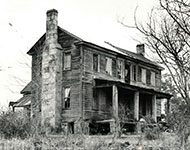
Located approximately six miles east of Lawrenceville, the county seat of Gwinnett, Dacula emerged out of the Chinquapin (the name of a north American chestnut tree) Grove community which was an area surrounded by cotton fields, early pioneers, and Creek and Cherokee Indians. “Living out here was like living in the wild west,” remarked Mayor Wilbanks during his presentation. While the county of Gwinnett was established in 1818, it wasn’t until 1892 that railroad workers set up a camp in the area, charged with developing the railroad line.
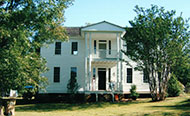
Mr. J. W. Hamilton has been credited as being the first settler of the town, building the first house in 1891.
However, it wasn’t until nearly fourteen years later that Dacula was incorporated on October, 1, 1905. Dr. S.L. Hinton served as the city’s first mayor.
Do you know how Dacula got its name?
The town was originally known as Hoke, named after a Seaboard Airline Railroad executive. Then the community proposed naming it after a prominent physician who was well-known for treating patients with pellagra, an epidemic condition in the rural south caused by a lack of niacin.
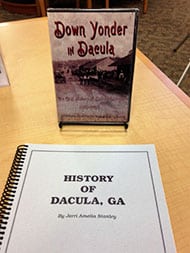
The vitamin deficiency was caused by a diet heavy in corn, rice, potato, and cabbage, lacking meats, vegetables, and dairy products. Dr. John W. Freeman, also the town’s first postmaster, was against the idea of naming the town after him. Instead, he pulled the letters from Decatur and Atlanta, thereby creating the name, Dacula.
“The railroad really opened up this area to freight and commerce,” Mayor Wilbanks pointed out. A railroad station helped to grow the town, but the station later closed in the 1950s. “We were a cotton farming community. That’s why we were out of school in the summer months to help pick cotton and use the cotton gin to separate the seeds from the cotton. I can recall the depot, platforms, and roads being stacked so full of cotton bales that you couldn’t get cars or trucks through. I remember walking on top of the bales to get from one side of the street to another as a kid.” The Mayor pointed to a slide. “In 1899 the price for one pound of cotton was 2.3cents. The standard size for an average bale weighed 500 pounds. That required a lot of work and manpower. In 1919, the price rose to thirty-five cents because the demand for cotton was very high. Why? The country was involved in World War 1. By 1931, the price of cotton dropped to five cents.” During the Great Depression, the economic impact hit hard, affecting cities and towns equally all across the country. Mayor Wilbanks commented that many of Dacula’s stores closed and even the Dacula Banking Company failed.
Did you know the county’s first courthouse and jail was established near the area later called, Dacula?
Elisha Winn built his home around 1812 and it was here that the discussions to create the county that was to be called, “Gwinnett,” occurred. According to the Gwinnett Historical Society, “Elisha Winn was a Justice of Inferior Court in Jackson County from 1815 to 1817. Elisha, together with Roger and Elijah Pugh, purchased the 7,300 acre Jones tract on the Apalachee River from the Jackson County tax collector in 1809 of which this property was part. The property became part of Gwinnett County on December 15, 1818….” The Winn barn was used as the first courthouse until a permanent location was established in Lawrenceville. Gwinnett’s first jail was situated not far from the barn. The Winn house, located at 908 Dacula Road, 1.9 miles north of Dacula city limits, has been fully restored and is being maintained by volunteers at the Gwinnett Historical Society. The home, listed on the National Register of Historic Places, hosts the annual Winn Fair which occurs in the Fall, the first weekend in October.
Did you know Dacula is the home of country music legends?
Gid Tanner and The Skillet Lickers were one of the most influential string bands in the 1920’s and 1930’s, influencing a new music genre later referred to as “Country” and “Bluegrass.” The first recording made with the Skillet Lickers was “Hand Me Down My Walking Cane,” recorded in Atlanta on April 17, 1926. The Tanner family band is still going strong and they continue to play every Friday night in Dacula. Their music can also be heard on 1680AM, Dacula’s low-power radio station. Roba Stanley, also from Dacula, is credited as being one of the first females to be recorded singing country music.
In 1910, Dacula had a population of 169 people. “The community consisted of two horse farms that ranged in size between forty to one hundred acres.” Mayor Wilbanks reflected. Beginning in the 1980s, Dacula experienced rapid population growth. In 2005, when the city celebrated its centennial birthday, the residential and commercial sectors continued to expand. According the U.S. Census in 2015, Dacula had a population of 5,333. The median age was thirty-five years old; the median household income was $79,610. “And, we’re continuing to grow. The city has issued two hundred building permits to date this year. Can you believe that?”
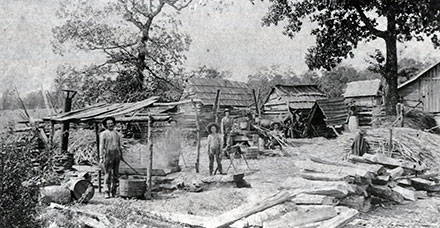
The City of Dacula is a community cradled between key transportation routes of Georgia Highway 316, U. S. 29, and the CSX Railroad. It is located in an area of economic development, dubbed “The Innovation Crescent.” The city is at the center of the Innovation Crescent with Athens at one end and Emory, Centers for Disease Control and Prevention (CDC), and Georgia Tech at the other. According to the city’s website, “The Innovation Crescent is a geographic area and a coalition of fifteen counties and other entities. It includes Gwinnett County and all of the City of Dacula. The Innovation Crescent covers nearly 40 percent of Georgia’s population. This is Georgia’s hub for life sciences. It is Georgia’s answer to the Research Triangle in North Carolina. The crescent includes top research organizations such as Emory University, Georgia Institute of Technology, the University of Georgia, the CDC, Georgia Gwinnett College, and Gwinnett Tech. It includes a wide range of scientific companies, large and small. The Innovation Crescent is becoming the hub of life science in the Southeast.”
The city’s vision and future is clear. “Our shared vision is that Dacula will be known as an inclusive community where businesses thrive and residents maximize potential through world-class schools, opportunities for life-long learning, a vibrant economy, diverse partnerships, and a superior quality of life.”
For more information about the history of Dacula, Dacula City Hall has the following items for sale: “History of Dacula,” written by Jerri Amelia Stanley ($20); “Down Yonder in Dacula, An Oral History of Dacula, GA, 1905 – 2005 (DVD – $10). The Gwinnett County Public Library – Dacula Branch and the Gwinnett Historical Society are also excellent resources.
For more information about the City of Dacula, visit: daculaga.gov.
For more information about The Skillet Lickers and their event schedule, visit: skilletlickers.org

